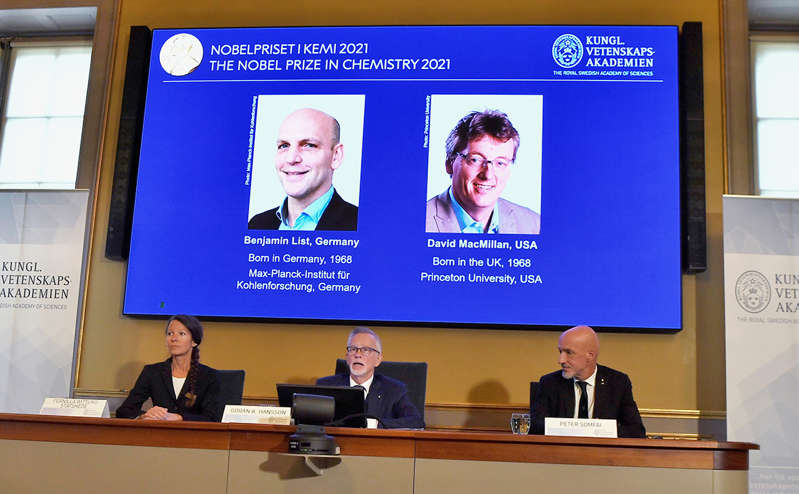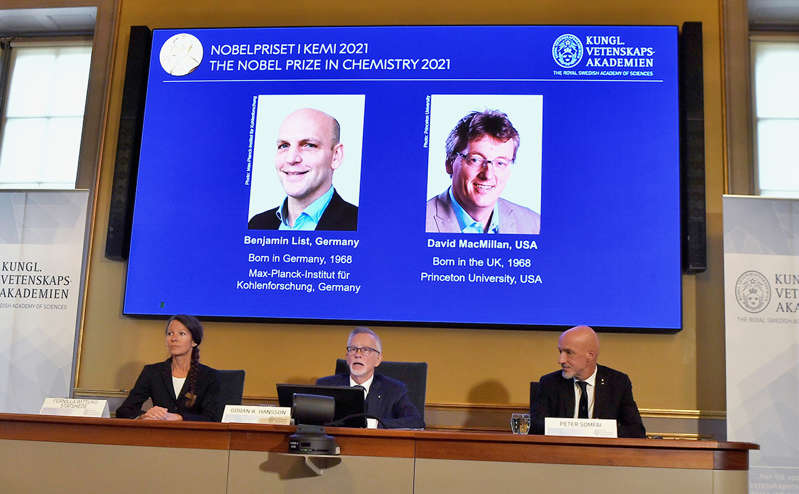
The 2021 Nobel Prize in Chemistry was awarded to Benjamin List and David McMillan “for the development of asymmetric organocatalysis.” In the message of the Nobel Committee it is noted that for a long time it was considered possible to use only metals and enzymes as catalysts, but about 20 years ago, List and Macmillan independently developed a third type of catalysis – using a framework of carbon atoms, to which atoms of more active elements, including oxygen, sulfur or phosphorus. These catalysts are environmentally friendly and cheap to manufacture.
“This concept of catalysis is as simple as it is ingenious, and the fact is that many people have wondered why we hadn't thought about it before,” said Johan Aquist, chairman of the Nobel Committee on Chemistry.
BREAKING NEWS:
The 2021 #NobelPrize in Chemistry has been awarded to Benjamin List and David W.C. MacMillan “for the development of asymmetric organocatalysis.” pic.twitter.com/SzTJ2Chtge— The Nobel Prize (@NobelPrize) October 6, 2021
The Nobel Committee specifically noted that the work of Liszt and Macmillan showed that organic catalysts can be used to trigger a variety of chemical reactions. Using them, scientists can more efficiently create new medicines or improve the efficiency of solar cells.
The total size of the Nobel Prize in 2021 is SEK 10 million ($ 1.145 million), which Liszt and Macmillan will share equally.
A year earlier, the Nobel Prize in Chemistry, for the first time in history, was shared by two women – American Jennifer Doudna and French Emmanuelle Charpentier, who were honored for the development of the method of genome editing known as “genetic scissors.”
This year, Nobel Week began on Monday 4 October: the winners of the Physiology or Medicine Prize were announced. They were American scientists David Julius and Ardem Pataputyan, whose work allowed scientists to understand how nerve impulses are initiated that allow people to perceive and adapt to the world around them, and to use knowledge to develop methods of treatment for a wide range of diseases.
On October 5, it was announced that half of the Nobel Prize in Physics for work on modeling the Earth's climate (German Klaus Hasselmann and American Shukuro Manabe) and the second half were awarded “for the discovery of how disorder and fluctuations interact in physical systems – on a scale from atomic to planetary” (to the Italian Giorgio Parisi).
On Thursday, October 7, the Nobel Committee will announce the laureate of the Literature Prize. On October 8, the Nobel Peace Prize laureate will be announced. Finally, on October 11, the Bank of Sweden will name the winner of the Alfred Nobel Memorial Prize in Economics (unofficially called the Nobel Prize in Economics, although it was founded not by Nobel himself, but by the Bank of Sweden in 1969).
From 1901 to 2020, the Nobel Prize in Chemistry was awarded 112 times, with the exception of 1916-1917, 1919, 1924, 1933 and 1940-1942. Over the years, 186 people have become its laureates, including the English biochemist Frederic Sanger twice – in 1958 “for the establishment of the structures of proteins, especially insulin”, and in 1980 “for his contribution to the establishment of base sequences in nucleic acids.” In most cases (63 times) one scientist received the prize, 24 times the award was shared between two and another 25 times between three laureates.
Most of all scientists from the USA are awarded the Nobel Prize in chemistry (72 people). The only chemist from our country to receive this award was Nikolai Semyonov, a participant in the Soviet atomic project in 1956, who developed the theory of chain reactions (the award was also presented to Cyril Hinshelwood).
The women received the Nobel Prize in Chemistry six times. The first – long before Charpentier and Dudna – was awarded this honor in 1911 for the discovery of radium and polonium by Maria Sklodowska-Curie. In 1935, her daughter Irene Joliot-Curie shared the prize with her husband Frederic Joliot-Curie. In 1964, biochemist Dorothy Crowfoot-Hodgkin received the Nobel Prize “for the determination of the structures of biologically active substances using X-rays.” In 2009, Israeli crystallographer Ada Yonat shared an award with two colleagues “for research on the structure and function of the ribosome.” In 2018, the American Francis Arnold received an award for her study of “directed evolution of enzymes.”


